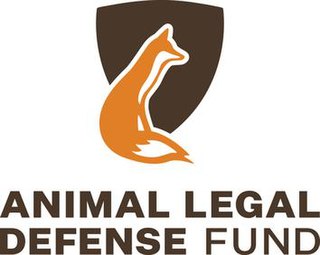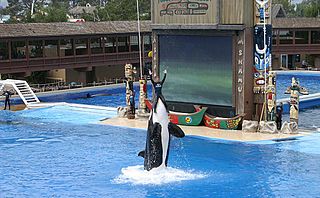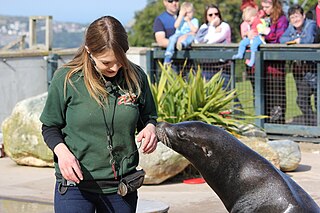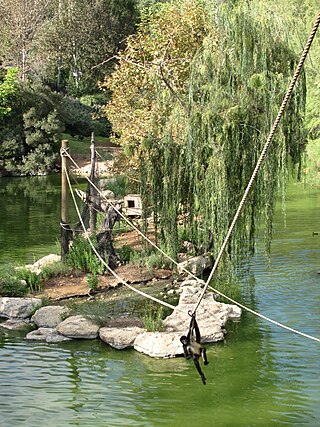This article needs additional citations for verification .(December 2009) |

An animal show is a form of exhibition featuring the display or performance of one or more breeds of animal. [1]
This article needs additional citations for verification .(December 2009) |

An animal show is a form of exhibition featuring the display or performance of one or more breeds of animal. [1]
An animal show can be for entertainment, educational, and/or commercial purpose. A judged event may rank specimens for the benefit of those involved in animal breeding or husbandry, or provide entertainment to animal fancy hobbyists.
The US Animal Welfare Act identifies a number of types of animal exhibitions:
Modern amusement parks often feature performing marine mammals and even contain drive-thru animal safari tours. The animal shows are typically operated by a contracted performer, while the animal parks are owned by the theme park itself. [1]
The US Animal Welfare Act prohibits the staging of dog fighting or baiting (including bear or raccoon-baiting). Cockfighting is outlawed in every state in the United States but is not banned nationally in the US. [1]
Animals perform tricks and stunts in the circus, marine mammal shows, amusement parks, carnivals, independent animal acts, television shows, movies, and educational exhibits. These can be licensed acts with booking agents. [1]
Animals can be displayed or be given as prizes by concessionaires at carnivals. [1]
Farm animals are exhibited at agricultural shows, fairs, and other exhibitions. [1] In the US, 4-H is actively involved in youth participation in the exhibition of livestock at county and state fairs and dedicated livestock shows.
Horse shows are competitions in which riders cause their horses to perform particular gaits and activities for recognition and prizes. [1]
Marine mammal shows include the display or performance of marine mammals such as polar bears, sea otters, whales, porpoises, dolphins, manatees, dugongs, seals, sea lions, walruses, and other mammals with fins or flippers. [1]
In 2013, Miller and his colleagues showed that dolphin shows and public interaction with dolphins increases « knowledge, attitudes and behavioral intentions » towards dolphins and their environment, on a limited time scale. They have also revealed that the more the shows were seen, the more people were taking conservation actions. [2]
Unfortunately, many studies have demonstrated that several marine mammals are not made for captivity and keeping them in these tanks is a form of cruelty. [3] Also, the main messages send by these shows are told to be controversial. [4]
To face these difficulties, Edge Innovation created a robotic dolphin. The goal is to keep educating and entertaining the public without having to keep marine mammals in captivity. [5]
Dog shows, cat shows, hamster shows, and rabbit shows are exhibitions for breeders and breed enthusiasts. [1]
The Westminster Kennel Club Dog Show has been held annually since 1877. Over 300,000 dogs were rated by 134 judges in 134 shows through 2011. [6]
Animals are sometimes used to attract business to a commercial enterprise, such as a bear at a gasoline service station, a monkey at a trade show, or an elephant at a shopping center. These animals are typically displayed but might also perform in a show. [1]
Farm animals and horses perform competitively at rodeos. [1]
Modern zoos often include animal shows for educational purposes. Petting zoos and roadside zoos are commercial enterprises that typically only display animals. [1]

A dolphin is an aquatic mammal within the infraorder Cetacea. Dolphin species belong to the families Delphinidae, Platanistidae, Iniidae, Pontoporiidae, and possibly extinct Lipotidae. There are 40 extant species named as dolphins.

Oceanic dolphins or Delphinidae are a widely distributed family of dolphins that live in the sea. Close to forty extant species are recognised. They include several big species whose common names contain "whale" rather than "dolphin", such as the Globicephalinae. Delphinidae is a family within the superfamily Delphinoidea, which also includes the porpoises (Phocoenidae) and the Monodontidae. River dolphins are relatives of the Delphinoidea.

Crufts is an international dog show held annually in the United Kingdom, first held in 1891. Organised and hosted by The Kennel Club, it is the largest show of its kind in the world.

A dolphinarium is an aquarium for dolphins. The dolphins are usually kept in a pool, though occasionally they may be kept in pens in the open sea, either for research or public performances. Some dolphinaria consist of one pool where dolphins perform for the public, others are part of larger parks, such as marine mammal parks, zoos or theme parks, with other animals and attractions as well.

The Vancouver Aquarium is a public aquarium located in Stanley Park in Vancouver, British Columbia, Canada. In addition to being a major tourist attraction for Vancouver, the aquarium is a centre for marine research, ocean literacy education, climate activism, conservation and marine animal rehabilitation.

The Animal Welfare Act was signed into law by President Lyndon B. Johnson on August 24, 1966. It is the main federal law in the United States that regulates the treatment of animals in research and exhibition. Other laws, policies, and guidelines may include additional species coverage or specifications for animal care and use, but all refer to the Animal Welfare Act as the minimally acceptable standard for animal treatment and care. The USDA and APHIS oversee the AWA and the House and Senate Agriculture Committees have primary legislative jurisdiction over the Act. Animals covered under this Act include any live or dead cat, dog, hamster, rabbit, nonhuman primate, guinea pig, and any other warm-blooded animal determined by the Secretary of Agriculture for research, pet use or exhibition. Excluded from the Act are birds, rats of the genus Rattus, mice of the genus Mus, farm animals, and all cold-blooded animals.

Marineland, is a themed zoo and amusement park in Niagara Falls, Ontario, Canada. The park has performing marine animal shows, exhibits of marine and land animals, and amusement rides. It keeps dolphins, sea lions, and beluga whales. Until 2023, the park also kept walruses and orcas. The park also keeps bears, deer, and other land animals. It was founded and operated by John Holer, a Slovenian immigrant, from 1961 until his death in 2018. It is privately owned and operated by his family.

SeaWorld San Antonio is a 250-acre (100 ha) marine mammal park, oceanarium and animal theme park in the Westover Hills District of San Antonio, Texas, on the city's west side. It is the largest of the three parks in the SeaWorld chain owned and operated by SeaWorld Parks & Entertainment. It is also one of the world's largest marine-life theme parks focused on conservation, education and animal rescue. It is a member of the Alliance of Marine Mammal Parks and Aquariums (AMMPA) and is accredited by the Association of Zoos and Aquariums (AZA).

The Animal Legal Defense Fund is an animal law advocacy organization. Its stated mission is to protect the lives and advance the interests of animals through the legal system. It accomplishes this by filing high-impact lawsuits to protect animals from harm, providing free legal assistance and training to prosecutors to assure that animal abusers are punished for their crimes, supporting tough animal protection legislation and fighting legislation harmful to animals, and providing resources and opportunities to law students and professionals to advance the emerging field of animal law. In addition to their national headquarters in Cotati, California, the Animal Legal Defense Fund maintains an office in Portland, Oregon.

The Pittsburgh Zoo & Aquarium is one of only six major zoo and aquarium combinations in the United States. Located in Pittsburgh, Pennsylvania's Highland Park, the zoo sits on 77 acres (31 ha) of park land where it exhibits more than 4,000 animals representing 475 species, including 20 threatened or endangered species.

A marine mammal park is a commercial theme park or aquarium where marine mammals such as dolphins, beluga whales and sea lions are kept within water tanks and displayed to the public in special shows. A marine mammal park is more elaborate than a dolphinarium, because it also features other marine mammals and offers additional entertainment attractions. It is thus seen as a combination of a public aquarium and an amusement park. Marine mammal parks are different from marine parks, which include natural reserves and marine wildlife sanctuaries such as coral reefs, particularly in Australia.

Behavioral enrichment is an animal husbandry principle that seeks to enhance the quality of captive animal care by identifying and providing the environmental stimuli necessary for optimal psychological and physiological well-being. Enrichment can either be active or passive, depending on whether it requires direct contact between the animal and the enrichment. A variety of enrichment techniques are used to create desired outcomes similar to an animal's individual and species' history. Each of the techniques used is intended to stimulate the animal's senses similarly to how they would be activated in the wild. Provided enrichment may be seen in the form of auditory, olfactory, habitat factors, food, research projects, training, and objects.
Canada's Accredited Zoos and Aquariums is an accreditation and advocacy organization representing zoos and aquariums within Canada. The organization states that its member zoos and aquariums care for more than 100,000 individual animals representing over 2000 species of wildlife, observed by an estimated 11 million visitors each year. The organization is a member of the International Union for Conservation of Nature and the World Association of Zoos and Aquariums.

A zoo is a facility in which animals are kept within enclosures for public exhibition and often bred for conservation purposes.

Planète Sauvage is a zoological park situated in the French Atlantic coast, in Port-Saint-Père near Nantes, in the Loire-Atlantique departement. Founded in 1992 by Monique and Dany Laurent and known as the Safari Africain until 1998, it was then operated by the Compagnie des Alpes between 2005 and 2015. Since that date the park has been the property of the multinational company Looping Group, whose main shareholder is a Belgian private equity fund of the Groupe Bruxelles Lambert. Its director is Philippe Vignaud.

An animal theme park, also known as a zoological theme park, is a combination of an amusement park and a zoo, mainly for entertainment, amusement, and commercial purposes. Many animal theme parks combine classic theme park elements, such as themed entertainment and amusement rides, with classic zoo elements such as live animals confined within enclosures for display. Many times, live animals are utilized and featured as part of amusement rides and attractions found at animal theme parks.

Dubai Dolphinarium is the first fully air-conditioned indoor dolphinarium in the Middle East, providing habitat to dolphins and seals, allowing the public to watch and interact with them through live shows and photo sessions. It is located in the creek side park at Bur Dubai near the Children's City. Dubai Dolphinarium was opened on May 21, 2008 by Dubai Municipality, and is sponsored and supported by Dubai government to provide the general public with entertainment and also educate them regarding dolphins, seals and other marine organisms. It was also reflected that interacting with such friendly mammals like dolphins will motivate young generation to protect marine life and the environment.
Korea Animal Rights Advocates (KARA) is a non-profit organization that supports animal welfare in Korea and deals with animal cruelty cases. It is also responsible for the care of abandoned animals and their adoption.

Adventure World is a theme park that integrates a zoo, a public aquarium, and an amusement park in the town on Shirahama, Wakayama Prefecture, Japan. It is operated by Hours Co., Ltd. (AWS), an affiliate of Marusue Co., Ltd. headquartered in Matsubara City, Osaka Prefecture. When it first opened on April 22, 1978, it was called "Nanki Shirahama World Safari."
{{cite web}}: CS1 maint: archived copy as title (link){{cite journal}}: CS1 maint: multiple names: authors list (link){{cite journal}}: CS1 maint: multiple names: authors list (link)